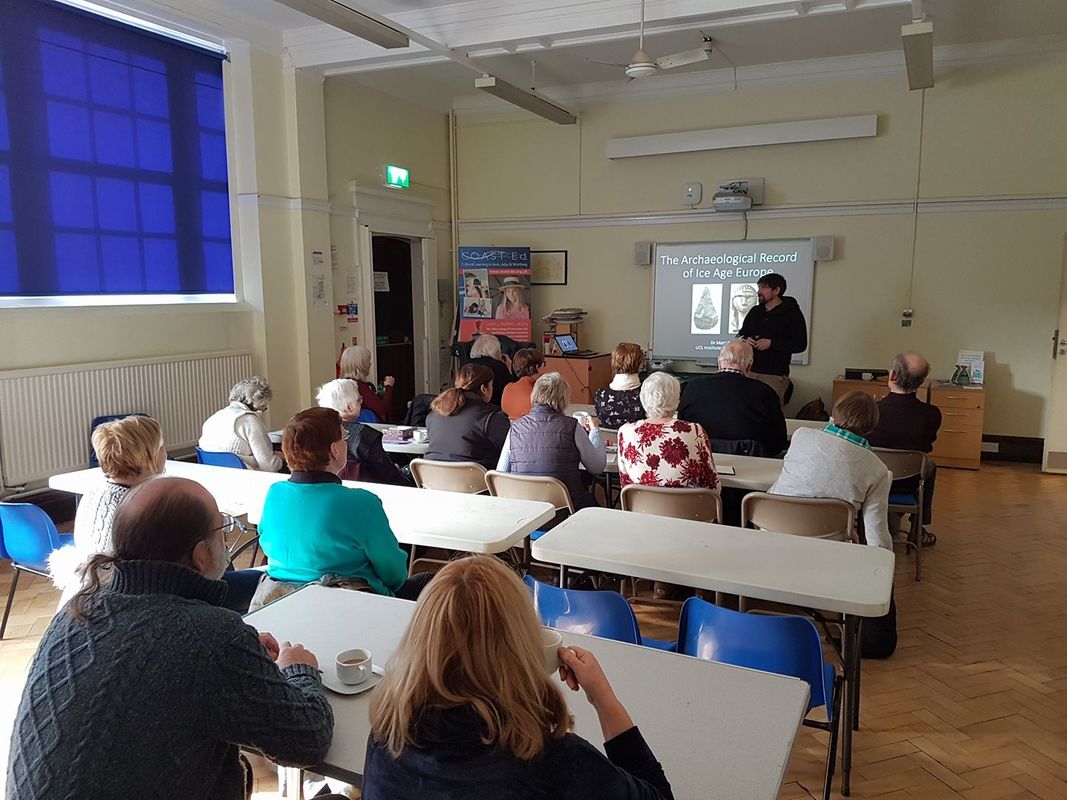This was a fascinating day with Matt Pope. He started by explaining how the Marine Isotope Curve was obtained and how it revealed the extent and frequency of different ice ages going back over a million years. Using the date of a specific archaeological event and the MI curve it is possible to identify the the MI Stage of the event and hence the climate at the time.
More detail here: https://en.m.wikipedia.org/wiki/Marine_isotope_stage
Simple cores and flake stone tools, had been found in Southern Europe dating back at least 1.5 million years. Human activity at Pakefield, Suffolk in the form of butchered bones and sharp fresh, dated to around 750,000 years ago corresponded to MIS19, a short lived warm period, so they did not need to adapt as they moved from the South. In contrast, at the earlier Happisburgh site in Norfolk, where again lots of cutting tools were found was dated over 850,000 years ago at which time the climate much cooler. These humans must have been sophisticated enough, and used clothing, to survive that climate.
We moved on to the Acheulian industry characterised by hand axes, the earliest found in Europe was in Spain dated from about 1 million years ago. We discussed which of the hominids had brought this industry to Europe, possibly Homo Heidelbergensis, also the different shapes and symmetries of hand axes and their purpose.
Matt told us about a cave site in France dating to 550k years ago which showed evidence of primary access to carcasses and refined hand-axe development, in different stratified layers covering MIS 13 , a temperate period, and MIS 12 a long intensely cold period when it could be seen that people had made intensified use of a cave. Possibly these humans had moved from North to South following the animals?
In the afternoon we moved on to the Middle Palaeolithic in Europe and the Neanderthals. With the number of hominoid species and the DNA evidence of interbreeding what was meant by human was being redefined and Neanderthals should be treated as humans.
We learned about the pit of bones found in Spain, dating from MIS 11, 420,000 years ago where 30 individuals were found in a pit together, possibly the earliest evidence of symbolic ritual in Europe. MIS 9 events revealed the earliest prepared cores in Europe, and hints of more complex behaviour, including wooden spears and possible stone structures.
Lots more evidence of Neanderthals sophistication have been establish in Europe predating the arrival of modern humans, some by more than 100,000 years, such as building structures, using fires and burying their dead. Other examples included collecting claws and wings of birds of prey, perforating and decorating shells and hand blown painting together with a ladder motif, at a cave in Northern Spain dating from 64,000ya.
With the arrival of modern humans in Europe around 45,000 years ago stone technologies; prismatic cores, blades, end scrapers, developed quickly and there was an explosion of art; carved bones and tusks, clay figures, musical instruments and cave paintings.
The day was packed with interest and enjoyed by us all. Thanks very much Matt for a brilliant day.
Jacqui
More detail here: https://en.m.wikipedia.org/wiki/Marine_isotope_stage
Simple cores and flake stone tools, had been found in Southern Europe dating back at least 1.5 million years. Human activity at Pakefield, Suffolk in the form of butchered bones and sharp fresh, dated to around 750,000 years ago corresponded to MIS19, a short lived warm period, so they did not need to adapt as they moved from the South. In contrast, at the earlier Happisburgh site in Norfolk, where again lots of cutting tools were found was dated over 850,000 years ago at which time the climate much cooler. These humans must have been sophisticated enough, and used clothing, to survive that climate.
We moved on to the Acheulian industry characterised by hand axes, the earliest found in Europe was in Spain dated from about 1 million years ago. We discussed which of the hominids had brought this industry to Europe, possibly Homo Heidelbergensis, also the different shapes and symmetries of hand axes and their purpose.
Matt told us about a cave site in France dating to 550k years ago which showed evidence of primary access to carcasses and refined hand-axe development, in different stratified layers covering MIS 13 , a temperate period, and MIS 12 a long intensely cold period when it could be seen that people had made intensified use of a cave. Possibly these humans had moved from North to South following the animals?
In the afternoon we moved on to the Middle Palaeolithic in Europe and the Neanderthals. With the number of hominoid species and the DNA evidence of interbreeding what was meant by human was being redefined and Neanderthals should be treated as humans.
We learned about the pit of bones found in Spain, dating from MIS 11, 420,000 years ago where 30 individuals were found in a pit together, possibly the earliest evidence of symbolic ritual in Europe. MIS 9 events revealed the earliest prepared cores in Europe, and hints of more complex behaviour, including wooden spears and possible stone structures.
Lots more evidence of Neanderthals sophistication have been establish in Europe predating the arrival of modern humans, some by more than 100,000 years, such as building structures, using fires and burying their dead. Other examples included collecting claws and wings of birds of prey, perforating and decorating shells and hand blown painting together with a ladder motif, at a cave in Northern Spain dating from 64,000ya.
With the arrival of modern humans in Europe around 45,000 years ago stone technologies; prismatic cores, blades, end scrapers, developed quickly and there was an explosion of art; carved bones and tusks, clay figures, musical instruments and cave paintings.
The day was packed with interest and enjoyed by us all. Thanks very much Matt for a brilliant day.
Jacqui

